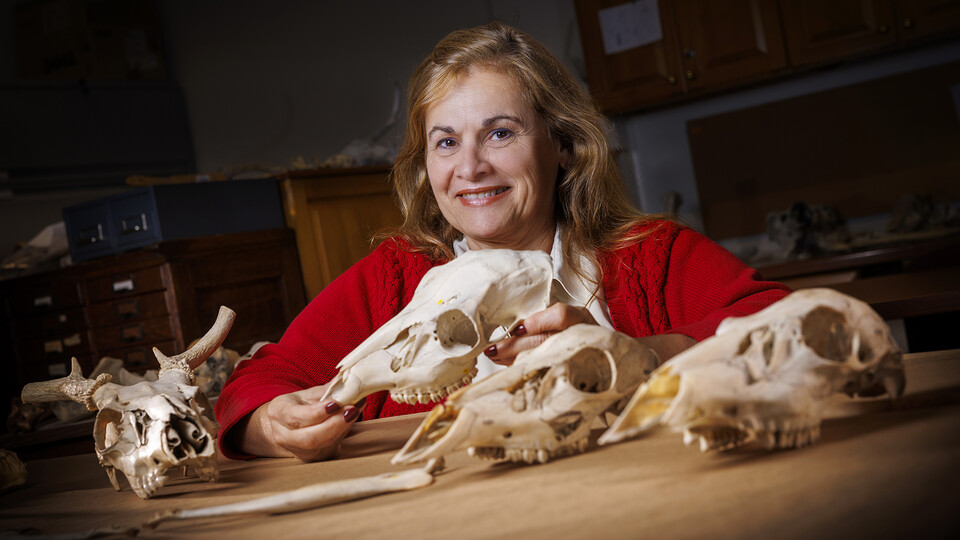· 5 min read
Perdikaris helps untangle history of fallow deer

For two decades, Nebraska’s Sophia Perdikaris has been helping decipher the origins and global distribution of fallow deer.
An environmental archaeologist at the University of Nebraska-Lincoln, Perdikaris maintains a research station on the Caribbean island of Barbuda where, despite the species’ status as national animal and cultural emblem, the fallow deer population could face extinction as a result of over-hunting and massive environmental destruction caused by Hurricane Irma in 2017.
“The Barbudan fallow deer possess great cultural importance and also occupy an important ecological niche,” Perdikaris said. “They are in critical need for protection.”
Fallow deer are mid-sized animals that often feature fawn-like white spots in their coats. “Fallow” refers to their pale brown color, but their coloring can vary to include black and white. Males have palmated antlers similar to moose.
Perdikaris, who leads the university’s School of Global Integrative Studies, is part of the Dama International project, a transdisciplinary study led by the University of Nottingham in England. Dama is the genus name for the two species of fallow deer.
She and other scientists recently co-authored a major summation of the fallow deer’s 10,000-year biocultural history, published by the Proceedings of the National Academy of Sciences. The article broke new ground on how fallow deer, which emerged from the Ice Age in the Balkans, Anatolia and Persia, came to be distributed across Europe and around the world.
Dama dama, or European fallow deer, are farmed in the millions and exhibit coat colorations indicative of selective breeding. Dama Mesopotamia, or Persian fallow deer, are designated as an endangered species by the International Union for the Conservation of Nature.
Although fallow deer live wild in parks and preserves around the world, they actually were among the earliest animals to be domesticated. Nearly all populations — whether in Europe, Africa or the Americas — were established by humans, who transplanted the deer for agricultural, hunting or religious and cultural reasons. Experts believe the only existing native wild population of fallow deer inhabits a national park in Turkey, where the species emerged after the Ice Age.
Perdikaris and her fellow researchers maintain that the fallow deer’s close entanglement with human history and its ambiguous status — neither fully wild nor fully domestic — raise significant questions about what species and populations are chosen for conservation efforts. In some locations, the animals have been dismissed as non-native invasive species unworthy of protection. Yet populations that were established centuries ago are vulnerable to extinction without careful management to avoid over-hunting and over-grazing.
“For me, the Barbudan story was the most important part of the whole project as it demonstrates just how incoherent and inconsistently applied international wildlife conservation policy is,” said Naomi Sykes, project leader and corresponding author for the latest study. “I’m so grateful to have met Sophia and learn about her research. Until I met Sophia and her Barbudan colleagues, I had no idea fallow deer was the national animal of the island.”
The newly published study conducted isotope, radiocarbon dating and genetic analysis of 635 bone samples acquired from ancient and modern sites, including samples Perdikaris collected from Barbuda. It also synthesized zooarchaelogical literature to reconstruct fallow deer distribution over space and time. Location and frequency were mapped for the Neolithic and Bronze Age, from 8000 to 1200 BCE; the Iron Age and Roman Age, 1200 BCE to 500 CE; and Medieval and Early Modern Age, 500 to 1800 CE.
The first author was Karis H. Baker of Durham University in the U.K., while Naomi Sykes of University of Exeter, also in the U.K., led the project and served as corresponding author.
“We … show how ancient humans have shaped the modern-day distributions and management strategies of these two species. As such, they present cultural heritage and arguably deserve protection by the United Nations Educational Scientific and Cultural Organization (UNESCO) as much as from wildlife conservation bodies such as the IUCN (International Union for Conservation of Nature),” the study states.
Persian fallow deer were transported to Cyprus by early farmers about 10,000 years ago. European fallow deer were moved from the Balkans to the islands of Chios and Rhodes about 7,000 years ago. Early farmers also established European fallow deer herds on the islands of Lemnos, Levos and Crete.
Although previous accounts assumed the deer were translocated for hunting purposes, the new study cites Bronze Age texts and iconography that indicate more complicated reasons. For example, Greek texts dating to about 1400 to 1200 BCE described three kinds of fallow deer: wild, tame, and those used for games and religious sacrifices. Fallow deer became associated with the Greek goddess Artemis and her Roman counterpart, Diana. During the Roman Empire, the deer were transported across Europe and into the British Isles.
The earliest evidence of fallow deer beyond the Mediterranean is at the palatial estate of Fishbourne in southern England, where remains date to the first century BCE. The Roman imports went extinct after the empire fell, but the deer were reintroduced to Britain during the medieval period.
Keeping fallow deer in parks became a statement of elite identity in England, where thousands of deer parks were established in the 16th century. Imperialism led to the deer being transported to British colonies worldwide.
One example was their introduction to Barbuda. As first author of a detailed 2018 study of Barbudan fallow deer, Perdikaris concluded the deer likely arrived soon after England’s Codrington family received the lease to the island in 1684. Christopher Codrington III, born in Barbados in 1668 but schooled at Oxford University, and his heir, William Codrington, who built a retirement home on Barbuda, likely believed fallow deer were a crucial part of a well-appointed estate.
Initially a symbol of colonial dominance, the deer became a symbol of freedom after Barbudan slaves were emancipated in 1834. Barbudan slaves had a very different attitude about the deer and the land compared to English traditions of hunting rights and elite land ownership. Hunting fallow deer is an integral part of Barbudan cultural identity.







